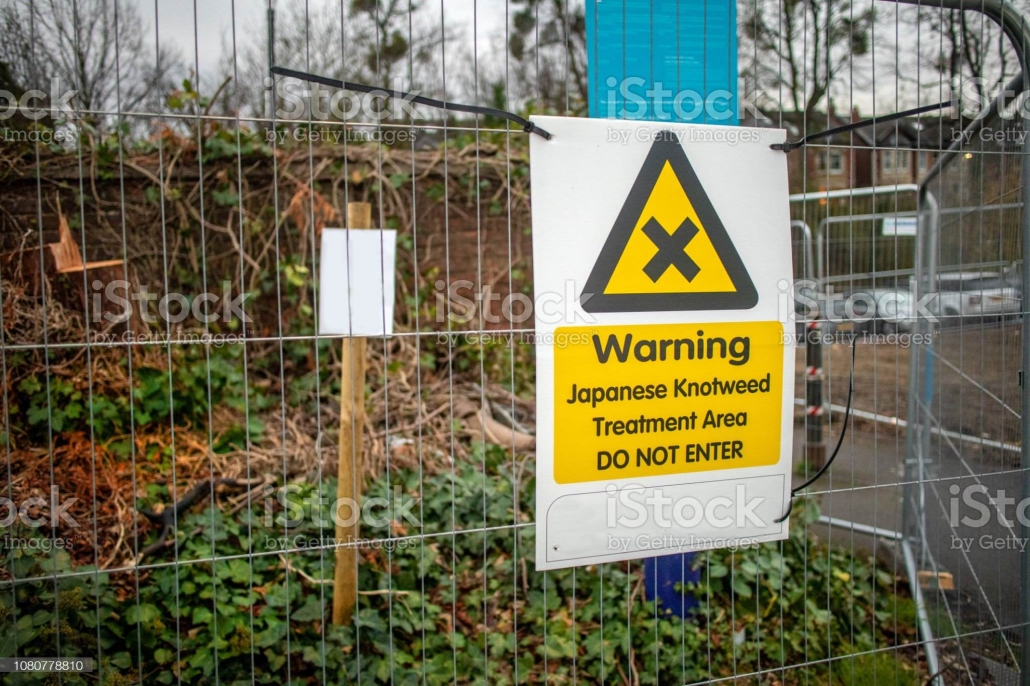Plants That Look Like Japanese Knotweed
Although it is quite distinctive, there are other pants, such as bindweed, that can be confused with the nasty knotweed, so always double check your suspicions. You can use a plant identifier app on your phone, or you can pay for a RICS Japanese knotweed survey.
Japanese Knotweed Survey
If you suspect that you might have Japanese Knotweed on your property then you should seek professional identification. Many Japanese Knotweed removal companies will offer an identification service free of charge, often they don’t even need to come out to the property they will make their assessment from photos that you provide.
If you have definitive proof that you have Japanese Knotweed on your property then you might want a more detailed survey which will include;
- Identification
- A map of all boundaries
- A risk assessment report that can be sent to a mortgage provider
- Detailed assessment of the size and potential threat of the infestation
- Suggested treatment methods based on your individual infestation
One of these surveys will cost around £250 although many companies will waive that cost if you decide to use them to remove the Japanese Knotweed. It is always favourable to look for a RICS (Royal Institute of Chartered Surveyors) approved supplier so you know that they are complying with current guidelines.
Why is selling a house with Japanese knotweed difficult?
Think about it; would you want to buy a house whose garden was eating it alive? Japanese knotweed is a world of hate that few homebuyers will want to take on, especially if there are less complicated options on the market. And that’s just the start of the problem.
Because Japanese knotweed poses such a threat to properties, many mortgage companies simply won’t take the risk. After all, their loan is secured on the property, and if it gets damaged, so does the security of their investment. That means that when you’re selling a house with Japanese knotweed, your market is not only reduced to buyers willing to take the risk, but also reduced further to those within that group who are cash buyers. Now that’s what you call a tough sell, and you need to accept that this will seriously impact the sale price.
What you shouldn’t do if you have Japanese knotweed
When you are facing a hit of 10-20% on the value of your home, you could be tempted to try to sort out the Japanese knotweed yourself, or to simply ignore it and hope no one notices. We cannot emphasise strongly enough what a bad idea both of these strategies are. You will not make things better, and you’ll probably make things much, much worse, and even more costly in the long run.
Despite this people have tried to kill the invasive pest themselves with some novel and some downright bizarre solutions such as;
Killing Japanese Knotweed With Diesel
For some strange reason a rumour got round that diesel was the solution to the Japanese Knotweed problem (yes the stuff that you put in your car to make it go). Now, being doused in litres of this highly volatile liquid will indeed kill most things on this planet but unfortunately Japanese knotweed is not among them. Although it will do some damage to the visible elements of the plant in actual fact the roots that are under the soil will be unaffected, meaning that the plant will grow back, only this time as a diesel fuelled mutant plant (ok that last bit might not be accurate). So you still have a garden infested with Japanese Knotweed only now it is saturated with highly toxic diesel and things just went from bad to worse.
Killing Japanese Knotweed With Bleach
If you’re thinking “well car fuel doesn’t work but what about the delightfully potent cleaning liquid bleach that’s sure to kill Japanese knotweed right?” Wrong! While it might be great at cleaning unwanted nasties from your toilet bowl, bleach will do nothing other than contaminate your soil if you go pouring it liberally around your garden. Similar to diesel, bleach will only damage the visible portion of the plant, leaving the roots unaffected and it will simply regrow.
Burning Japanese Knotweed
Many people believe that if “Japanese Knotweed” is the question then “fire” must be the answer, after all it did a great job of eradicating those sausages at uncle Joe’s barbecue last summer. Alas, when it comes to getting rid of Japanese knotweed burning just doesn’t cut the mustard. You might think that you have reduced it to a smouldering pile of ash but the roots remain unscathed and ready to regrow and start your nightmare once more.
Spraying Japanese knotweed
Japanese Knotweed can be controlled with herbicide. The right herbicides can reduce the growth and stop the spread. Unfortunately though this is not just some off the shelf weed killer that you can buy in your local DIY store. The Chemical Treatment that will yield results needs to be administered with a treatment plan from a professional Japanese knotweed removal company. These treatment plans often come with an insurance backed guarantee but depending on the circumstances herbicide is not always the best solution.
Eating Japanese knotweed
“Desperate times call for desperate measures” as the saying goes. Believe it or not there are almost 100 searches on Google per month for “eating Japanese knotweed” but as it turns out is not as foolish as you might think, at least in as far as it is technically edible (with a taste akin to lemony rhubarb apparently). Don’t get your pie dishes out just yet though, disposing of Japanese knotweed without a licence is a criminal offence, and serving your friends an invasive plant species for dessert is a huge social faux pa. Also, as with the previous DIY methods the roots remain intact so the plant will grow back so unfortunately you can’t eat yourself out of trouble. Although recently the invasive plant has appeared on the menu at pop-up restaurants in London designed to raise awareness around these tasty pests.
So unless you are a licensed expert, treating it yourself is not an option, you will be left with a highly toxic garden and a bad taste in your mouth.
Neither is ignoring it. If left untreated, Japanese knotweed will spread rapidly, making the problem so much worse and if it spreads to neighbouring properties or into the wild you can be liable for the clean up. So how can you get rid yourself of this garden menace?
How to get rid of Japanese Knotweed – Safely Remove Japanese Knotweed
Japanese knotweed needs to be dealt with by a professional company who specialise in treatment and eradication. Simply digging it out yourself will not be enough, and you risk spreading it to neighbouring properties who can then sue you for damages. You also risk prosecution if you don’t dispose of the plant in a very specific way, as approved by the environment agency. This is the ‘nuclear waste’ of the plant world. It can survive burning and must be buried at least 5 metres deep or wrapped in membranes that will last for at least 50 years.








 Cash House Buyer Guru
Cash House Buyer Guru